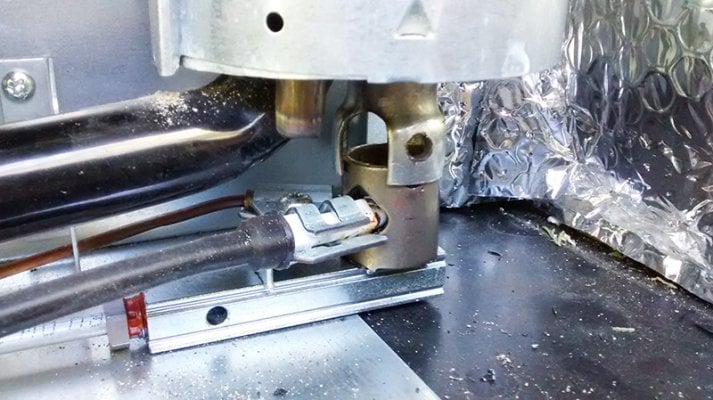I’m trying to access the burner on my Dometic 2193 refrigerator (1.9 cu ft 3-way), but I can’t figure out how to slide the burner out from under the flanges on the bottom of the boiler tube.
I had some trouble lighting the fridge, which is probably a problem of my own making – I took the propane tank out to weigh it to see how full it was, and after I reconnected it, I forgot to purge the air out of the line by running the range. Instead I tried lighting the fridge, which stayed lit for 10 or 15 seconds before going out.
After this the fridge wouldn’t relight using the piezo igniter. When I got it lit with a barbeque lighter (because I wasn’t sure if the igniter was the problem), the flame had a lot of yellow and sputtered. I eventually got it going with a blue flame, but I can still see some carbon deposits glowing in the burner
.
So I figured on cleaning the burner. I removed the wind screens and removed the screw holding the burner to the boiler tube flanges. The burner will then drop down, but it won’t drop down far enough - the bottom of the burner is resting on the floor of the fridge cavity, but the top of the burner is still about ¼ inch above the bottom of the three boiler tube flanges. The only way I can see to get the burner out from under the flanges is to either raise the whole boiler tube/flue assembly, or use pliers to bend the flanges (and I expect bending metal is not the solution).
What am I missing – how do you get the burner out from under the flanges?
Thanks in advance!
I had some trouble lighting the fridge, which is probably a problem of my own making – I took the propane tank out to weigh it to see how full it was, and after I reconnected it, I forgot to purge the air out of the line by running the range. Instead I tried lighting the fridge, which stayed lit for 10 or 15 seconds before going out.
After this the fridge wouldn’t relight using the piezo igniter. When I got it lit with a barbeque lighter (because I wasn’t sure if the igniter was the problem), the flame had a lot of yellow and sputtered. I eventually got it going with a blue flame, but I can still see some carbon deposits glowing in the burner
.
So I figured on cleaning the burner. I removed the wind screens and removed the screw holding the burner to the boiler tube flanges. The burner will then drop down, but it won’t drop down far enough - the bottom of the burner is resting on the floor of the fridge cavity, but the top of the burner is still about ¼ inch above the bottom of the three boiler tube flanges. The only way I can see to get the burner out from under the flanges is to either raise the whole boiler tube/flue assembly, or use pliers to bend the flanges (and I expect bending metal is not the solution).
What am I missing – how do you get the burner out from under the flanges?
Thanks in advance!





